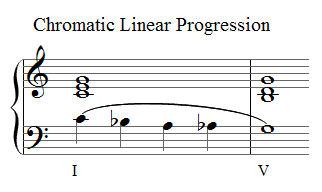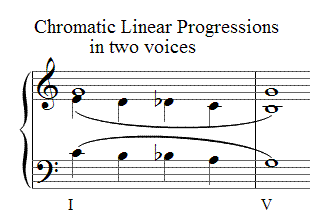APPENDIX A: VOICE LEADING OVERVIEW
The Chromatic Linear Progression
In the strict counterpoint of the 16th century linear progressions were made up of diatonic step by step movement between notes on strong beats. See section on linear progressions. However, in tonal music the scope can be extended to include chromatic stepwise movements. The example below shows a chromatic linear progression in one part:

I've used the slur as an analytical symbol to show the extent of the linear progression. Here, it is not intended to have its normal meaning. Chromatic linear progressions can be made up totally of semitone steps or can be made up of a combination of semitone and tone steps as above. They always contain a combination of diatonic and chromatic notes. The linear progression (diatonic or chromatic) always connects a harmony note of one structural (or functional) chord to a harmony note of another structural chord This may be the same chord or a different chord as in the example above. Here, the voice leading decorates the underlying chord progression which is chord I to chord V.
Just as diatonic linear progressions can be combined in parallel 3rds, 6ths or 10ths, chromatic linear progressions can be combined in parallel. In the following example, chromatic linear progressions move in parallel 3rds:

Again the movement is a voice leading movement that decorates the underlying I to V chord progression. The chords incidentally created by the linear progression (G major, G diminished, A minor 7) are just the result of the voice leading and do not constitute a fundamental chord progression. Note: the example above involves movement between major and minor thirds and parallel minor thirds. Parallel movement involving consecutive major thirds is normally (but not always) avoided.
See Book Chapter 4 for further details and examples of Diatonic and Chromatic Linear Progressions.
Next Topic: The Chromatic Appoggiatura

